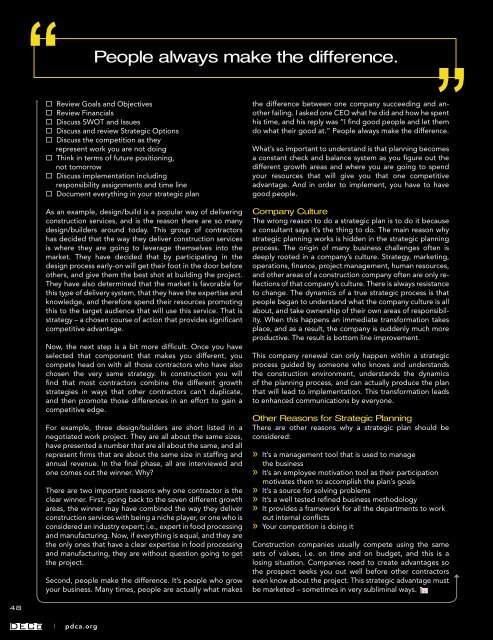n o v/d e c • 2 0 0 8 - Subscribe
n o v/d e c • 2 0 0 8 - Subscribe
n o v/d e c • 2 0 0 8 - Subscribe
You also want an ePaper? Increase the reach of your titles
YUMPU automatically turns print PDFs into web optimized ePapers that Google loves.
48<br />
“<br />
� Review Goals and Objectives<br />
� Review Financials<br />
� Discuss SWOT and Issues<br />
� Discuss and review Strategic Options<br />
� Discuss the competition as they<br />
represent work you are not doing<br />
� Think in terms of future positioning,<br />
not tomorrow<br />
� Discuss implementation including<br />
responsibility assignments and time line<br />
� Document everything in your strategic plan<br />
As an example, design/build is a popular way of delivering<br />
construction services, and is the reason there are so many<br />
design/builders around today. This group of contractors<br />
has decided that the way they deliver construction services<br />
is where they are going to leverage themselves into the<br />
market. They have decided that by participating in the<br />
design process early-on will get their foot in the door before<br />
others, and give them the best shot at building the project.<br />
They have also determined that the market is favorable for<br />
this type of delivery system, that they have the expertise and<br />
knowledge, and therefore spend their resources promoting<br />
this to the target audience that will use this service. That is<br />
strategy – a chosen course of action that provides significant<br />
competitive advantage.<br />
Now, the next step is a bit more difficult. Once you have<br />
selected that component that makes you different, you<br />
compete head on with all those contractors who have also<br />
chosen the very same strategy. In construction you will<br />
find that most contractors combine the different growth<br />
strategies in ways that other contractors can’t duplicate,<br />
and then promote those differences in an effort to gain a<br />
competitive edge.<br />
For example, three design/builders are short listed in a<br />
negotiated work project. They are all about the same sizes,<br />
have presented a number that are all about the same, and all<br />
represent firms that are about the same size in staffing and<br />
annual revenue. In the final phase, all are interviewed and<br />
one comes out the winner. Why?<br />
There are two important reasons why one contractor is the<br />
clear winner. First, going back to the seven different growth<br />
areas, the winner may have combined the way they deliver<br />
construction services with being a niche player, or one who is<br />
considered an industry expert; i.e., expert in food processing<br />
and manufacturing. Now, if everything is equal, and they are<br />
the only ones that have a clear expertise in food processing<br />
and manufacturing, they are without question going to get<br />
the project.<br />
Second, people make the difference. It’s people who grow<br />
your business. Many times, people are actually what makes<br />
| pdca.org<br />
People always make the difference.<br />
”<br />
the difference between one company succeeding and another<br />
failing. I asked one CEO what he did and how he spent<br />
his time, and his reply was “I find good people and let them<br />
do what their good at.” People always make the difference.<br />
What’s so important to understand is that planning becomes<br />
a constant check and balance system as you figure out the<br />
different growth areas and where you are going to spend<br />
your resources that will give you that one competitive<br />
advantage. And in order to implement, you have to have<br />
good people.<br />
Company Culture<br />
The wrong reason to do a strategic plan is to do it because<br />
a consultant says it’s the thing to do. The main reason why<br />
strategic planning works is hidden in the strategic planning<br />
process. The origin of many business challenges often is<br />
deeply rooted in a company’s culture. Strategy, marketing,<br />
operations, finance, project management, human resources,<br />
and other areas of a construction company often are only reflections<br />
of that company’s culture. There is always resistance<br />
to change. The dynamics of a true strategic process is that<br />
people began to understand what the company culture is all<br />
about, and take ownership of their own areas of responsibility.<br />
When this happens an immediate transformation takes<br />
place, and as a result, the company is suddenly much more<br />
productive. The result is bottom line improvement.<br />
This company renewal can only happen within a strategic<br />
process guided by someone who knows and understands<br />
the construction environment, understands the dynamics<br />
of the planning process, and can actually produce the plan<br />
that will lead to implementation. This transformation leads<br />
to enhanced communications by everyone.<br />
Other Reasons for Strategic Planning<br />
There are other reasons why a strategic plan should be<br />
considered:<br />
» It’s a management tool that is used to manage<br />
the business<br />
» It’s an employee motivation tool as their participation<br />
motivates them to accomplish the plan’s goals<br />
» It’s a source for solving problems<br />
» It’s a well tested refined business methodology<br />
» It provides a framework for all the departments to work<br />
out internal conflicts<br />
» Your competition is doing it<br />
Construction companies usually compete using the same<br />
sets of values, i.e. on time and on budget, and this is a<br />
losing situation. Companies need to create advantages so<br />
the prospect seeks you out well before other contractors<br />
even know about the project. This strategic advantage must<br />
be marketed – sometimes in very subliminal ways.








